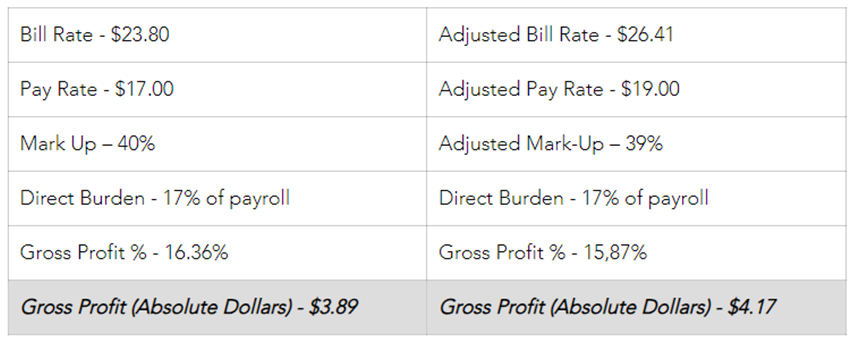By Nick Andriacchi, National Sales Executive, Madison Resources
Employee wages and benefit costs continue to rise. Every staffer has experienced this.
In states like Illinois (IL) and New Jersey (NJ) where low-skilled temporary laborers are now mandated to be paid at the same rate as full-time employees, staffing companies are navigating this shifting landscape to maintain profitability. Despite the pressure on margins due to mandated and market wage increases, staffing firms can enhance raw profit dollars by keeping markup on labor consistent.
The new legislation requires companies to equalize pay rates between temporary and full-time workers, creating challenges for staffing agencies that predominantly employ low-skilled temporary labor. It has a similar effect as wages rising due to market pressures. To adapt, these agencies can adjust their markup strategies to ensure the overall bill rates remain competitive and sustainable. While this might lead to a decrease in percentage margins, the absolute profit dollars generated can increase, contributing to the firm’s financial stability.
C-O-M-M-U-N-I-C-A-T-E
When communicating these changes to their customers, staffing companies should be transparent about the reasons for the adjustments in bill rates. It’s essential to educate clients about the regulatory changes and/or rising wages that have necessitated alterations in pricing structures. By presenting the lower margins as a result of rising compensation, staffing agencies can demonstrate their commitment to their clients – while absolute dollar profit is higher.
Its All in the Numbers
Let’s take a state mandated pay and benefit increase for example. IL and NJ have laws on the books that require lower skilled labor be compensated the same as the lowest paid full-time employee with a similar job description. If the staffing agency must raise its pay rate by $2.00 per hour to compensate contract employees for wages and benefits, as long as the mark-up stays about equal the absolute dollar profit is higher.
-
All numbers hourly
Bottom line – even if the staffing agency doesn’t pass the entire cost in terms of a little lower mark-up (39% vs 40%) , the agency makes more money because the bill rate is more.
Again the staffing agency should focus the clients attention to the lower gross profit percentage and not the higher bill rate.
Benefits of a higher compensated, better skilled talent
Additionally, staffing firms can emphasize the long-term benefits of attracting and maintaining a skilled and motivated workforce, ultimately enhancing productivity and overall company performance. In most markets, paying minimum wage will not attract quality talent. And even if they do accept the position, they won’t last long as most other employers are offering better compensation. Communicating this with your clients will help build trust and help them understand the current job market better, enhancing the partnership.
While the rise in wages and benefit costs presents challenges to staffing companies, they can adapt by adjusting markup strategies to maintain profitability. Communicating these changes transparently to clients, emphasizing compliance with state mandates/rising wages, and highlighting the positive impact on workforce quality can help build stronger relationships and ensure continued success in the evolving labor market.



